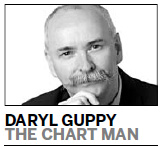Daryl Guppy
'Monetary-policy tightening to remain'
By Daryl Guppy (China Daily)
Updated: 2011-05-16 13:18
 |
Large Medium Small |

Inflation comes from many sources. One of the important inflationary forces in recent times has been the rise in commodity prices to speculative highs. This has been driven by a cheap US dollar that has created a speculative bubble in some commodities. Silver was one of the largest bubbles, but it also developed in gold and copper. It is the speculation in industrial metals that has helped to increase inflation, so any retreat in the commodity markets is welcome news.
Chart analysis provides information about the potential for this commodity retreat to continue, or to decide if it is temporary. The situation is a mixture of mechanical system changes that have developed some end-of-trend price behaviors.
The Chicago Mercantile Exchange (COMEX) is the home for silver trading and last week it increased margins for futures trading several times. This was not unexpected. In previous columns we noted that American Federal Reserve Chairman Ben Bernanke hinted at similar moves in his comments about clearing and settlement issues. This type of regulatory change, or the threat of regulatory change, changes the conditions for trading in the market. It makes it more difficult to execute some trading strategies.
| ||||
A reliable trend reversal pattern is the head-and-shoulder pattern. Very large and deep patterns lead to very powerful trend reversals. This is shown by the head-and-shoulder pattern in the Dow Jones Industrial Average Index that developed in late 2007 with the right shoulder completed in January 2008. This provided accurate downside targets for the Dow index.
The head-and-shoulder pattern in copper is small. It starts with the peak of the left shoulder in January with a high of $448. The head in the pattern is created by the high at $462 in February. The right shoulder of the pattern is quickly developed in April with a high of $450. The neckline of the pattern joins the low in January at $421, with the low in March at $412.
The pattern is confirmed when the price is not able to rally and stay above the value of the neckline. The head-and-shoulder pattern is invalidated if the price moves above the peak of the right shoulder at $450.
The neckline slopes down. Some traders believe this makes the head-and-shoulder pattern more bearish. Our research shows the slope of the neckline line is not important for the strength of the reversal. The distance between the head and the midpoint of the neckline is the most important feature for deciding the strength of the trend reversal.
The distance between the peak of the head and the neckline is measured and this value is projected downward to give a downside target. For copper the target is near $375. This is a minimum target. In a falling market this target is often exceeded. The $375 level is an historical support or resistance level so the price may develop a rebound from this level. If the price falls below this level then there is also strong support near $360. This increases the probability of a rebound developing from between $360 and $375.
Failure of support near $360 confirms a new downward trend has developed. In the short term, any rebound from $360 must close above $450 before it is confirmed as a new upward trend. This is the peak of the right shoulder of the head-and-shoulder pattern.
These short-term falls signal a return to the underlying long term upward trend. This trend still contains rising price pressures, but not at the fast accelerating rate of recent months. These slow rising price pressures are more easily absorbed in the economy.
The changes in margin rates and the threat that these exchanges will extend to other commodity markets has slowed the commodity speculation bubble but it has not changed the long-term secular trend. The NYMEX oil price has fallen below $100. This makes it appear that the oil prices drop simply returns it to the long term upward trend that started in 2010 June. The oil price can fall to $95 or $96 and still remain consistent with the long-term upward trend.
The rise in commodity prices has slowed, but the underlying long-term trend has not changed. Inflationary pressures from commodities have eased but they have not disappeared. This in turn suggests that monetary-policy tightening measures will continue so traders attention will shift to changes in the currency markets.
The author is a well-known international financial technical analysis expert.
| 分享按钮 |



